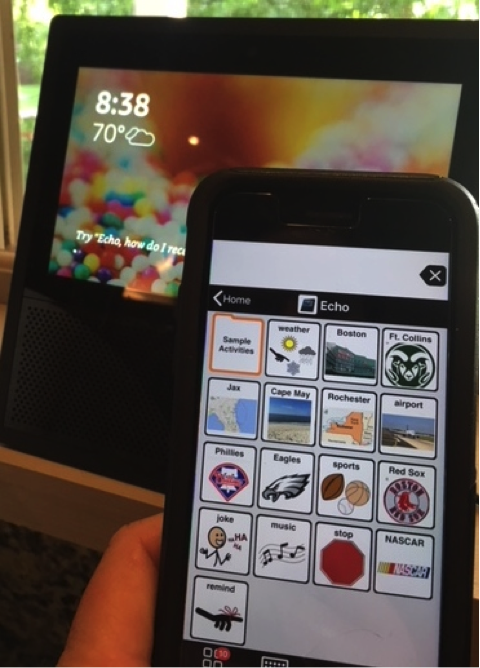
It’s first thing in the morning and Kyle just woke up. He enters the kitchen and walks towards the Echo Show. He selects a pre-programmed question from his phone. “Echo, did the Phillies win last night?” Echo replies, and Kyle is pleased.
If you thought Alexa or Google Home devices couldn’t work with alternative communicators, you are mistaken! This was me. As a mom always looking for ways to help her son maximize his independence, I thought anything that requires voice activation would only cause him frustration. I was dismissing intelligent personal assistant devices because of my son’s limited verbal communication skills. What I am discovering is with a little creativity, it’s not only possible, but also empowering.
My son Kyle is 19 years old and a typical teen in so many ways. He loves sports, music, friends, his dogs, and is never without his iPhone. He uses many ways to communicate, including pictures on his phone, informal gestures, some ASL sign language and some limited verbal speech. We have always encouraged a total communication approach or any alternative way to help him get his point across, including AAC. I didn’t know if an intelligent personal assistant would be able to understand him, but I wanted to try.
Since Kyle is a visual learner, we chose the Echo Show over the other products on the market . Not only can he hear Echo’s answers, but a visual appears on the screen, like the weather report or Phillies score.
At first, Kyle was curious and watched us talk to Echo, but wasn’t confident to try it himself. We used “Echo” as our wake up word instead of Alexa, Amazon or computer because Echo was the easiest for Kyle to verbally say. On our first attempt with the Echo, I tried to ask for a reminder to drop off my son’s Toyota at the service station for inspection. This seemed simple enough. Echo repeated to me, “Ok, you have a reminder for 3pm to drop off the toilet!” Toilet?? (Clearly, there is going to be a learning curve here!) I explained to Kyle that Echo was having trouble understanding me. I think watching my failed attempt gave Kyle permission to try it himself; he had nothing to lose. He tried it. “Echo, drop off Toy-Toyota”. With Kyle’s slight speech stutter, Echo interpreted, “OK, drop off the torah torah”. This wasn’t right either. I was ready to give up, thinking this is only going to cause frustration. I mentioned this experience at Kyle’s SETT meeting at school to our Assistive Technology Consultant and she suggested getting Kyle’s communication app to talk to Echo.
Kyle uses the Proloquo2go picture-based communication app on his iPhone. We set up a simple grid in Proloquo2go with some of Kyle’s favorite things. With this accommodation, Kyle can use his phone to ask Echo to play music, stop the music, and tell us the weather in our area and the places his dad travels to work. Kyle can also ask if the Phillies or Sixers won their games last night. We can set up reminders like what time to leave for school or work, or even not forgetting to brush his teeth! Smart home technology and intelligent personal assistants are becoming a valuable resource to help anyone gain independence. Limitations in verbal communication skills do not need to be a barrier.
During my search for the best approach for Kyle, I came across some other helpful tools. Check out these links as well as our Smart Homes Made Simple Resources.
Think Smart Box– a pre-programmed communication grid that works with Alexa
Ask My Buddy– a free service that allows users to have Alexa or Google Home contact their personal alert network of friends, family or personal care professional
Alexa things to try– useful phrases to help you get started with Alexa
Alexa drop in feature– allows you to connect with friends and family, even if you aren’t in the room

